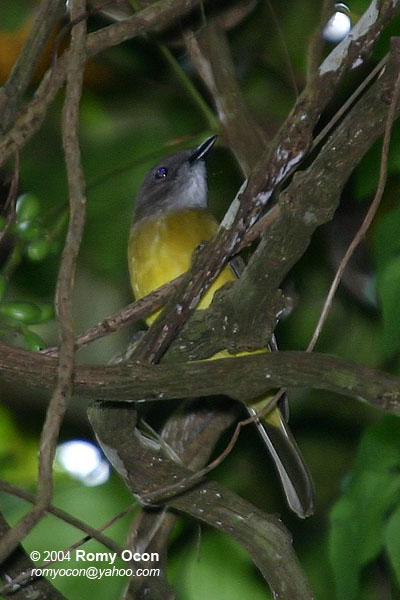(completed) |
(References updated) |
||
| Line 1: | Line 1: | ||
| − | [[Image:Yellow-bellied_Whistler.jpg|thumb|550px|right|Nominate subspecies<br />Photo by {{user|Romy+Ocon|Romy Ocon}}<br /> | + | [[Image:Yellow-bellied_Whistler.jpg|thumb|550px|right|Nominate subspecies<br />Photo by {{user|Romy+Ocon|Romy Ocon}}<br />Mount Makiling, Laguna Province, [[Philippines]], August 2004]] |
;[[:Category:Pachycephala|Pachycephala]] philippinensis | ;[[:Category:Pachycephala|Pachycephala]] philippinensis | ||
==Identification== | ==Identification== | ||
| Line 14: | Line 14: | ||
Common but population decreasing in some areas. | Common but population decreasing in some areas. | ||
==Taxonomy== | ==Taxonomy== | ||
| − | Seven subspecies recognized: | + | Forms a superspecies with [[Sulphur-bellied Whistler]] and [[Bornean Whistler]]. |
| + | ====Subspecies==== | ||
| + | Seven subspecies recognized<sup>[[#References|[1]]]</sup>: | ||
* ''P. p. fallax'' on Calayan, northern [[Philippines]] | * ''P. p. fallax'' on Calayan, northern [[Philippines]] | ||
* ''P. p. illex'' on Camiguin Norte, northern [[Philippines]] | * ''P. p. illex'' on Camiguin Norte, northern [[Philippines]] | ||
| Line 22: | Line 24: | ||
* ''P. p. siquijorensis'' on Siquijor, south-central [[Philippines]] | * ''P. p. siquijorensis'' on Siquijor, south-central [[Philippines]] | ||
* ''P. p. basilanica'' on western Mindanao and Basilan, southern [[Philippines]] | * ''P. p. basilanica'' on western Mindanao and Basilan, southern [[Philippines]] | ||
| − | + | ||
==Habitat== | ==Habitat== | ||
Moist lowland forests and montanes. Occurs from sea-level up to 1200m. | Moist lowland forests and montanes. Occurs from sea-level up to 1200m. | ||
==Behaviour== | ==Behaviour== | ||
| + | ====Diet==== | ||
Feeds on insects.<br /> | Feeds on insects.<br /> | ||
| − | Usually foraging in understorey but may also be seen higher up. Joins mixed-species flocks. | + | Usually foraging in understorey but may also be seen higher up. Joins mixed-species flocks. |
| − | Breeding recorded in February and June. The nest is an open cup made of fine roots and leaves. It's placed in the understorey, at least 3m above the ground. Lays 2 - 3 eggs. | + | ====Breeding==== |
| + | Breeding recorded in February and June. The nest is an open cup made of fine roots and leaves. It's placed in the understorey, at least 3m above the ground. Lays 2 - 3 eggs. | ||
| + | ====Movements==== | ||
Resident species. | Resident species. | ||
==References== | ==References== | ||
| − | #{{Ref- | + | #{{Ref-Clements6thAug14}}#{{Ref-HBWVol12}} |
{{ref}} | {{ref}} | ||
==External Links== | ==External Links== | ||
Latest revision as of 17:30, 11 December 2014
- Pachycephala philippinensis
Identification
15 - 16cm.
- Brownish-grey crown and brownish head (crown grey in apoensis)
- Olive-green upperparts, paler in some subspecies
- Olive-green tail
- White chin and throat with faint streaking
- Dull yellow underparts
- Washed grey olive upper breast in nominate, missing in other subspecies
Sexes similar. Juveniles have a rufous breast and belly
Distribution
Endemic to the Philippines.
Common but population decreasing in some areas.
Taxonomy
Forms a superspecies with Sulphur-bellied Whistler and Bornean Whistler.
Subspecies
Seven subspecies recognized[1]:
- P. p. fallax on Calayan, northern Philippines
- P. p. illex on Camiguin Norte, northern Philippines
- P. p. philippinensis on Luzon and Catanduanes, northern Philippines
- P. p. apoensis on Samar, Biliran, Leyte, Dinagat, Pujada and most of Mindanao
- P. p. boholensis on Bohol, south-central Philippines
- P. p. siquijorensis on Siquijor, south-central Philippines
- P. p. basilanica on western Mindanao and Basilan, southern Philippines
Habitat
Moist lowland forests and montanes. Occurs from sea-level up to 1200m.
Behaviour
Diet
Feeds on insects.
Usually foraging in understorey but may also be seen higher up. Joins mixed-species flocks.
Breeding
Breeding recorded in February and June. The nest is an open cup made of fine roots and leaves. It's placed in the understorey, at least 3m above the ground. Lays 2 - 3 eggs.
Movements
Resident species.
References
- Clements, J. F., T. S. Schulenberg, M. J. Iliff, D. Roberson, T. A. Fredericks, B. L. Sullivan, and C. L. Wood. 2014. The eBird/Clements checklist of birds of the world: Version 6.9., with updates to August 2014. Downloaded from http://www.birds.cornell.edu/clementschecklist/download/
- Del Hoyo, J, A Elliott, and D Christie, eds. 2007. Handbook of the Birds of the World. Volume 12: Picathartes to Tits and Chickadees. Barcelona: Lynx Edicions. ISBN 978-8496553422
Recommended Citation
- BirdForum Opus contributors. (2024) Yellow-bellied Whistler. In: BirdForum, the forum for wild birds and birding. Retrieved 19 April 2024 from https://www.birdforum.net/opus/Yellow-bellied_Whistler




